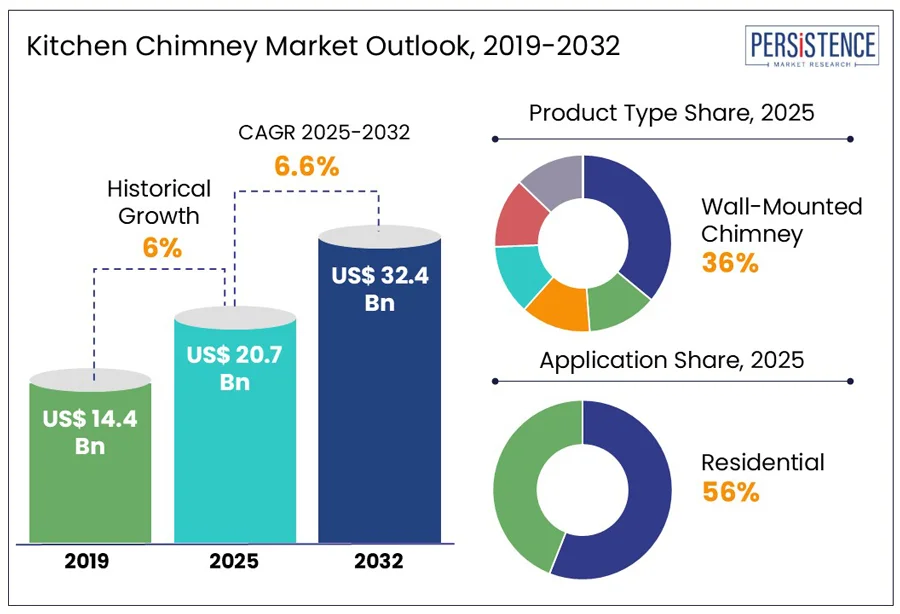ID: PMRREP35417| 198 Pages | 11 Jun 2025 | Format: PDF, Excel, PPT* | Consumer Goods

The global kitchen chimney market size is anticipated to rise from US$ 20.7 Bn in 2025 to US$ 32.4 Bn by 2032. It is projected to witness a CAGR of 6.6% from 2025 to 2032. According to the Persistence Market Research report, the kitchen chimney market is evolving rapidly, driven by rising health awareness, modern kitchen designs, and the need for smoke-free cooking. As households embrace smarter, cleaner cooking environments, kitchen chimneys are no longer a luxury but a necessity, transforming kitchens worldwide into more efficient, stylish, and hygienic spaces.

Key Industry Highlights:
|
Global Market Attribute |
Key Insights |
|
Kitchen Chimney Market Size (2025E) |
US$ 20.7 Bn |
|
Market Value Forecast (2032F) |
US$ 32.4 Bn |
|
Projected Growth (CAGR 2025 to 2032) |
6.6% |
|
Historical Market Growth (CAGR 2019 to 2024) |
6% |
Homeowners today are showing a strong preference for modular kitchens that offer a blend of space optimization, functional design, and modern aesthetics. As living spaces become smaller, especially in urban areas, there is a growing need for kitchen solutions that are both compact and efficient. Wall-mounted chimneys perfectly align with these needs, as they are specifically designed to fit into modular kitchen setups without occupying floor space. Positioned above cooktops, they effectively extract smoke, grease, and odors, ensuring a cleaner and healthier cooking environment. Their sleek design complements contemporary kitchen decor, making them a practical and visually appealing choice for urban households.
Elica introduced the iSMART range featuring inverter technology, brushless DC motors, and motion sensors. These wall-mounted chimneys offer up to 60% power savings and are designed for modern modular kitchens.
Faber launched a wall-mounted chimney with steam clean and auto-clean technologies, tailored for modular kitchens. It features gesture and touch controls, enhancing user convenience.
The kitchen chimney market faces a significant restraint due to the widespread availability and continued use of alternative ventilation options such as exhaust fans and conventional range hoods. These alternatives are generally more affordable, easier to install, and require minimal maintenance, making them appealing to cost-conscious consumers, especially in developing regions. In many households, particularly where cooking is less oil-intensive, exhaust fans are considered sufficient for basic ventilation needs. Traditional range hoods often come pre-installed in older homes or rental units, reducing the urgency to upgrade. This accessibility and familiarity with alternatives limit the overall market penetration of kitchen chimneys.
Modern consumers are prioritizing appliances that align with their digitally connected lifestyles, leading to a surge in demand for smart kitchen chimneys that offer convenience, automation, and control. These advanced models feature built-in Wi-Fi, mobile app integration, and compatibility with smart assistants like Alexa and Google Assistant, enabling users to operate them remotely or through voice commands.
Motion sensors allow touch-free activation, enhancing hygiene and ease of use. Beyond convenience, smart chimneys support energy optimization, usage tracking, and timely maintenance alerts. This growing preference for intelligent appliances is transforming kitchen chimneys from basic ventilation tools into innovative, user-centric lifestyle products.
Ducted chimneys dominate the kitchen chimney market due to their superior performance in expelling smoke, heat, grease, and odors directly outside the home. Unlike ductless variants, which rely on internal filters to recirculate air, ducted systems offer powerful suction and continuous ventilation, making them ideal for heavy-duty cooking, especially in cuisines that involve frying and spices. Their long-term efficiency and lower maintenance needs make them a preferred choice for residential as well as commercial kitchens. While installation may require more space and structural adjustments, the effectiveness and durability of ducted chimneys continue to drive their widespread adoption across global markets.
The commercial segment of the kitchen chimney market, though smaller than residential, plays a crucial role, especially in restaurants, hotels, cloud kitchens, and large-scale food service establishments. These setups require high-capacity chimneys with powerful suction, durability, and continuous operation capabilities to manage intense cooking volumes. Commercial chimneys are often customized with ducted systems, multi-layer filters, and heat-resistant materials to handle smoke, grease, and odors efficiently. Growing demand for hygiene, safety compliance, and workplace air quality is driving investments in advanced commercial ventilation systems. As the global foodservice industry expands, particularly in urban centers, the need for industrial-grade kitchen chimneys is steadily rising.

In North America, there is a growing preference for energy-efficient and noise-free built-in kitchen chimneys, especially among homeowners undertaking premium kitchen renovations. These chimneys are seamlessly integrated into cabinetry or walls, offering a sleek, space-saving solution without compromising performance. Their quiet operation and low energy consumption appeal to environmentally conscious consumers seeking both comfort and sustainability.
As modern kitchen aesthetics trend toward minimalism and smart functionality, built-in chimneys align perfectly with these priorities. The demand is particularly strong in upscale residential markets, where homeowners are investing in high-end appliances that enhance both functionality and the overall visual appeal of contemporary kitchen spaces.
In Europe, the growing emphasis on sustainable kitchen designs is significantly influencing consumer choices, particularly in favor of eco-conscious kitchen chimneys. Homeowners and commercial users are increasingly opting for chimneys built with recyclable filters, energy-efficient motors, and eco-friendly materials like stainless steel and tempered glass. This shift is driven by stricter environmental regulations, rising awareness about carbon footprints, and the desire for greener living spaces.
Manufacturers are responding by launching models that not only ensure effective ventilation but also align with sustainability goals. As a result, eco-friendly chimneys are becoming an integral part of modern, responsible kitchen setups across the region.
In the Asia Pacific region, the rapid growth of the middle-class population is transforming homeownership patterns and driving demand for modern kitchen solutions. As disposable incomes rise, more households are investing in appliances that enhance comfort, hygiene, and indoor air quality. Increasing awareness of the harmful effects of indoor air pollution caused by traditional cooking methods has significantly boosted the adoption of kitchen chimneys.
Urban consumers, particularly in densely populated cities across India, China, and Southeast Asia, are prioritizing health and cleanliness. As a result, chimney adoption is becoming a standard feature in new urban homes and modern apartment kitchens.
The global kitchen chimney market is highly competitive, characterized by a mix of established players and emerging brands striving to gain market share through innovation, design, and technology integration. Companies are focusing on energy-efficient, low-noise, and smart chimneys to cater to evolving consumer preferences. Product differentiation, pricing strategies, and distribution networks are key competitive levers.
The market also sees frequent product launches and technological upgrades to maintain brand relevance. With increasing demand across residential and commercial sectors, manufacturers are expanding their presence in emerging economies while investing in R&D to align with sustainability trends and smart home integration.
The global kitchen chimney market is projected to value at 20.7 bn in 2025.
The kitchen chimney market is driven by increasing urbanization and the rise of modular kitchens for wall-mounted chimneys in residential households.
The kitchen chimney market is poised to witness a CAGR of 6.6% between 2025 and 2032.
The growing adoption of smart home ecosystems is the key market opportunity.
Major players in the kitchen chimney market include lica, Faber, Bosc, Siemens, Whirlpool, Samsung, and others.
|
Report Attributes |
Details |
|
Historical Data/Actuals |
2019 - 2024 |
|
Forecast Period |
2025 - 2032 |
|
Market Analysis Units |
Value: US$ Bn/Mn, Volume: As applicable |
|
Geographical Coverage |
|
|
Segmental Coverage |
|
|
Competitive Analysis |
|
|
Report Highlights |
|
|
Customization and Pricing |
Available upon request |
By Product Type
By Technology
By Application
By Region
Delivery Timelines
For more information on this report and its delivery timelines please get in touch with our sales team.
About Author